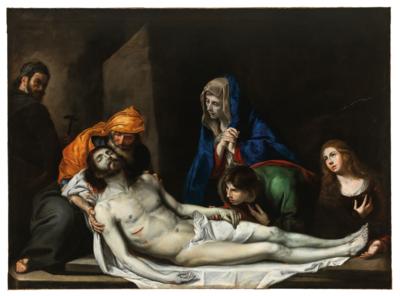Neapolitan School, 17th Century

The Entombment of Christ,
oil on canvas, 180 x 246 cm, framed
Provenance:
Aristocratic collection, Marche, until 2019;
where acquired by the present owner
The present painting shows the entombment of Christ with almost life-size figures, creating the immediate involvement of the viewer. From left to right appear Nicodemus and Joseph of Arimathea, followed by the Madonna, Saint John and Mary Magdalen. The composition follows an undulating line animated by the viewing directions of the figures and the complementary contrasts of colour, activated in their robes, which stand out from the dark background. The pale, sculptural corpse of Christ is shown along the foreground and invites the viewer to take part in the lamentation. The high emotionality of the scene is enforced by the figures’ shiny, reddened eyes.
The work relates to a yet unidentified prototype by Jusepe de Ribera, which is known through several copies of the subject (see N. Spinosa, Ribera. La obra completa, Madrid 2008, p. 521). On several occasions throughout his career Ribera executed variations of the subject, from depositions, to pietàs, lamentations and entombments.
Following his early formation which probably took place in Valencia alongside Francisco Ribalta, Jusepe de Ribera moved to Italy, staying in Parma (1611) and Rome (1613–16). In 1616 he established himself in Naples at the invitation of the viceroy, the Duke of Osuna, where Ribera was to remain for the next thirty-five years, leaving an indelible mark on the local tradition of painting, both upon the native painters Francesco Guarino, Giovanni Ricca, Bartolomeo Bassante, Luca Giordano and many others, as well as on the northern painters active in the city, including Hendrick van Somer and Matthias Stom.
The author of the present painting is therefore to be identified among the painters in the immediate entourage of Ribera, which included many artists of great ability. The use of pallid, cold colours, reminiscent of the style of Mattia Preti, and the features of the Magdalene, which are comparable to the delicate female figures of Pietro Ricca and Francesco Guarino, serve to signal that we are before an artist who was well integrated within the Neapolitan context of the fourth and fifth decades of the seventeenth century.
Specialist: Mark MacDonnell
 Mark MacDonnell
Mark MacDonnell
+43 1 515 60 403
mark.macdonnell@dorotheum.at
03.05.2023 - 18:00
- Estimate:
-
EUR 100,000.- to EUR 150,000.-
Neapolitan School, 17th Century
The Entombment of Christ,
oil on canvas, 180 x 246 cm, framed
Provenance:
Aristocratic collection, Marche, until 2019;
where acquired by the present owner
The present painting shows the entombment of Christ with almost life-size figures, creating the immediate involvement of the viewer. From left to right appear Nicodemus and Joseph of Arimathea, followed by the Madonna, Saint John and Mary Magdalen. The composition follows an undulating line animated by the viewing directions of the figures and the complementary contrasts of colour, activated in their robes, which stand out from the dark background. The pale, sculptural corpse of Christ is shown along the foreground and invites the viewer to take part in the lamentation. The high emotionality of the scene is enforced by the figures’ shiny, reddened eyes.
The work relates to a yet unidentified prototype by Jusepe de Ribera, which is known through several copies of the subject (see N. Spinosa, Ribera. La obra completa, Madrid 2008, p. 521). On several occasions throughout his career Ribera executed variations of the subject, from depositions, to pietàs, lamentations and entombments.
Following his early formation which probably took place in Valencia alongside Francisco Ribalta, Jusepe de Ribera moved to Italy, staying in Parma (1611) and Rome (1613–16). In 1616 he established himself in Naples at the invitation of the viceroy, the Duke of Osuna, where Ribera was to remain for the next thirty-five years, leaving an indelible mark on the local tradition of painting, both upon the native painters Francesco Guarino, Giovanni Ricca, Bartolomeo Bassante, Luca Giordano and many others, as well as on the northern painters active in the city, including Hendrick van Somer and Matthias Stom.
The author of the present painting is therefore to be identified among the painters in the immediate entourage of Ribera, which included many artists of great ability. The use of pallid, cold colours, reminiscent of the style of Mattia Preti, and the features of the Magdalene, which are comparable to the delicate female figures of Pietro Ricca and Francesco Guarino, serve to signal that we are before an artist who was well integrated within the Neapolitan context of the fourth and fifth decades of the seventeenth century.
Specialist: Mark MacDonnell
 Mark MacDonnell
Mark MacDonnell
+43 1 515 60 403
mark.macdonnell@dorotheum.at
|
Buyers hotline
Mon.-Fri.: 10.00am - 5.00pm
old.masters@dorotheum.at +43 1 515 60 403 |
| Auction: | Old Master Paintings |
| Auction type: | Saleroom auction with Live Bidding |
| Date: | 03.05.2023 - 18:00 |
| Location: | Vienna | Palais Dorotheum |
| Exhibition: | 22.04. - 03.05.2023 |
